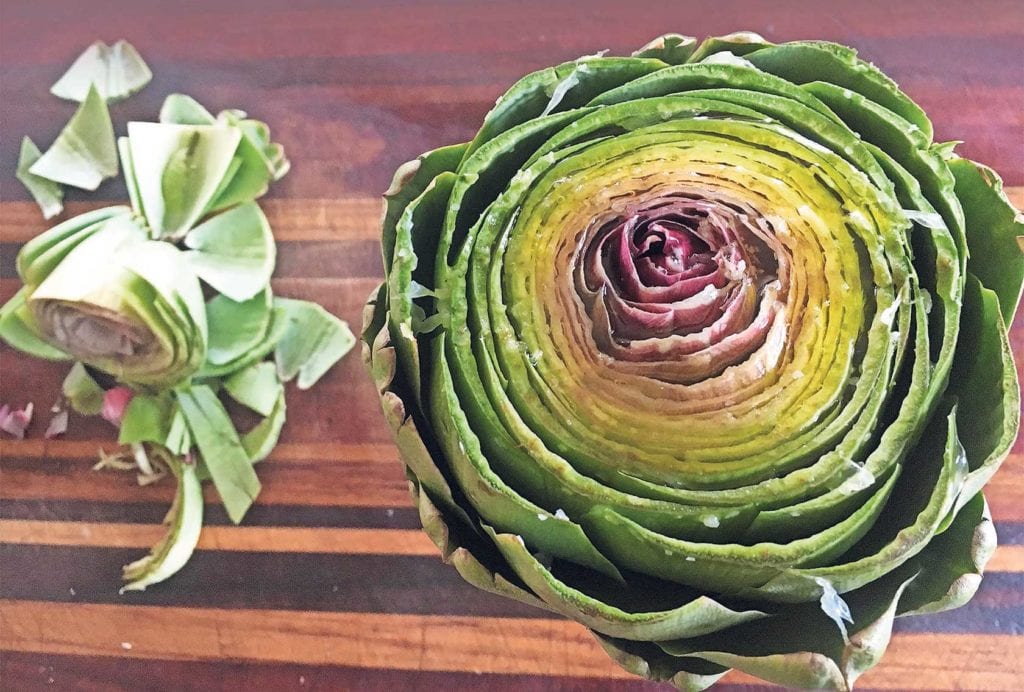
This is the time of year when artichoke fans have two reasons to cheer. The harvest has already begun in Mexico and the southern U.S., which means the large flower buds can already be found in stores. Meanwhile, at farmers markets of all latitudes, purveyors of bedding plants are selling potted artichokes for the garden. Even in Montana, the summers are getting hot enough that these Mediterranean members of the thistle family need to be planted a full 5 feet apart.
Artichoke buds are harvested before they bloom into flowers. Unless, of course, you prefer to allow them to flower and look at rather than eat them.
Myrna Varner became an artichoke grower when a vendor — Luci Brieger of Lifeline Produce in Victor, Montana — gifted her a baby plant as she was buying tomato starts. Now Varner grows three plants a year, and they produce later into the fall than the tomatoes.
“I’m ready to tear the garden up and they were still bearing,” she told me.
‘The best of thistles’
“It is good for a man to eat thistles, and to remember that he is an ass,” notes Eneas Sweetland Dallas in his 1877 book “Kettner’s Book of the Table: A Manual of Cookery, Practical, Theoretical, Historical.” “There are several elaborate ways of dressing the artichoke — the Barigoule way and Lyonnese way, for example.”
He calls these fancy methods “frantic attempts to paint the lily and to perfume the violet.”
I think Dallas is spot-on in his less-is-more approach to artichokes.
“Depend upon it,” he concludes, “the simplest way of dressing the artichoke is the best.”
How to prepare
Dallas recommends boiling the bud, but there is a case to be made for a roasting. I enjoy the caramelized flavors and the layers of texture that can result from some oven time. I like roasting artichokes so much, in fact, I roast them twice.
First I trim them, by laying the artichokes on their sides on a cutting board and giving them flat-tops with a big, heavy knife. On each artichoke, slice a round, flat plane an inch or two from the tip. This reveals a cross-section of green, purple, pale yellow and burgundy leaves. Trim the stem to within two inches of the bottom.
Place each head in a baking container in such a way that it can stay upright — by which we mean flat side up. In a wide-mouth pint jar, the artichoke looks like a flower in a vase. A Pyrex measuring cup does the same thing. A banana bread dish holds two large artichokes, side by side. If you don’t have anything that will work, trim the bottoms off so they sit flat and upright unsupported, and wing it from there.
Put a half-inch of water and a clove of garlic at the bottom of whatever container you use, and set the artichoke(s) in place. Give a solid shake or two of salt onto the top of each artichoke, followed by two tablespoons lemon or lime juice, poured slowly enough that it seeps down between the leaves. Then slowly pour in about a third of a cup of olive oil per large artichoke.
Cover each artichoke in foil, pressing firmly on all sides to make a seal between the foil and the thing that’s holding the artichoke. With the water in the bottom, you are essentially constructing a steamer.
Place the upright artichoke in its holder in the oven at 350 and bake (jars should be placed on a tray or skillet in case they tip). As it cooks, the oil will find its way down through the vascular tissue of the bud, through the stem and out the cut end and into the water below.
After an hour, carefully remove the artichoke and holder from the oven, and take off the foil. When it has cooled enough to handle, gently pull the leaves away from the center, working all away around the artichoke, loosening the bud as if you were trying to force it to bloom. Get the lemon oil from below the artichoke and pour it back into the top of the half-baked artichoke, and put it back in the oven with the foil off, so the outer leaves get crispy as the center melts into a molten core of flavor.
Cook about another hour, until the leaves pull off easily.






